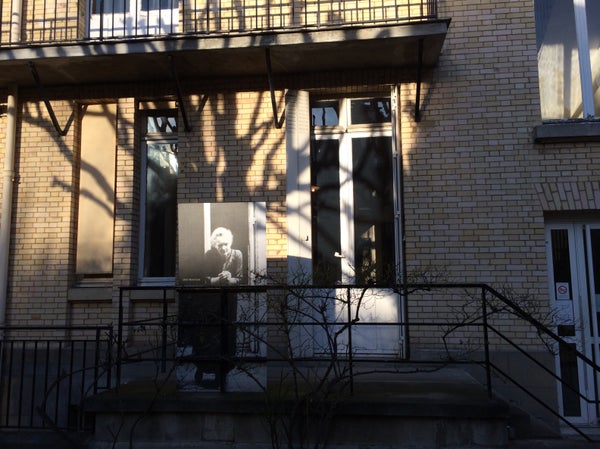本文发表于《大众科学》的前博客网络,反映了作者的观点,不一定反映《大众科学》的观点
居里博物馆是一个小型的免费博物馆,隐藏在巴黎的居里研究所研究园区内。它不是大多数巴黎游客的首选,但如果您发现自己身处拉丁区,花一个小时左右的时间在这里参观会很有趣。
玛丽·居里一直让我感到遥不可及。她是第一位两次获得诺贝尔奖的科学家,我很难想象她不是一个高高在上的天才,总是弓着腰伏在笔记本或实验室设备上,她的思维速度比任何人都快。她是否和我们其他人存在于同一个层面?她应该是一个鼓舞人心的人物,但我一直无法将她视为我可以效仿的人。我怎么能希望与如此高不可攀的人相提并论呢?
居里夫人和她的遗物实际上是不可触摸的事实,并没有帮助我感觉与她更亲近。她的遗骸具有放射性,因此被安葬在铅衬棺材中。博物馆中的一些文件是复制品,而不是真品,因为她的许多遗物仍然具有太强的放射性,不能靠近博物馆参观者。佩戴防护服的研究人员可以将它们从法国国家图书馆铅衬储藏箱中取出,但他们需要签署一份弃权书,表明他们意识到风险。
关于支持科学新闻报道
如果您喜欢这篇文章,请考虑通过以下方式支持我们屡获殊荣的新闻报道 订阅。通过购买订阅,您将帮助确保有关塑造我们当今世界的发现和想法的具有影响力的故事的未来。
但我参观居里博物馆的经历帮助我将玛丽·居里视为一个真实的人。
居里博物馆位于居里夫人本人在 1914 年至 1934 年工作的实验室中。它展出了 1920 年代和 1930 年代的镭热潮、居里家族及其工作,以及后来的镭研究所(现在的居里研究所)所做的工作。参观者可以窥视居里夫人的旧办公室,想象居里夫人本人在那里主持工作。在建筑物外,一张真人大小的居里夫人照片靠在栏杆上,望着她的花园,沉思着放射性的秘密。这张照片似乎正是在它现在展示的同一地点拍摄的,过去的一瞥就站在现在。很容易想象居里夫人花了大量时间倚靠在那栏杆上,陷入沉思。
但我在其中一个展示柜中发现的一封信,比她凝视花园的沉思午后照片更让我觉得她人性化。
“我们必须解决一个与实验用交流电(照明和动力)供应有关的小困难”,信中开头写道。当我读到它时,我忍不住笑了。玛丽·居里也和我们一样!在她完成工作之前,她也必须处理行政和后勤上的麻烦事!
不幸的是,我不知道这封信是写给谁的,也不知道她试图解决的确切性质是什么。从我所能判断的来看,她试图在进行实验的房间里正确设置交流电,但我不知道她试图克服的具体后勤障碍是什么。无论如何,这封信让我可以想象玛丽·居里,这位杰出的天才,她实验室的女皇,在做着 1924 年相当于发送技术支持电子邮件的事情,以将实验室电脑连接到大学网络。
您可以在下面阅读这封信的全文和我翻译的版本。
Cher ami,
Nous avons à résoudre une petite difficulté relative à la fourniture du courant alternatif (éclairage et force) au service des manipulations. J’avais espéré que chacun de nous pourrait avoir ses propres lignes commandées par un transformateur placé dans sa propre cabine, avec connexions facultatives. Ainsi on aurait évité toute comptabilité et toute difficulté de surveillance. Mais il parait que nous ne pouvons être autorisés à poser ce double système de lignes et que par suite nous ne pourrons pas avoir faire dépendre les lignes du service de manipulations comme toutes les autres lignes de notre annexe, d’un transformateur de haute tension placé dans notre cabine. Cela nécessiterait, d’une part, un accord sur votre participation aux frais de fourniture de courant alternatif, d’autre part un accord de principe sur le service et les responsabilités. Il est, en effet, absolument nécessaire que nous dehors des heures de service et pendant les jours de vacances. Ceci ne présenterait pas de difficulté si, comme je le suppose, vous n’utillesez le local que pour vos manipulation a l’époque où vous en disposerez, il y aurait de ce coté une difficulté que vous pourriez résoudre le mieux, je crois, en vous servant de lignes volantes venant de votre laboratoire.
Il importe que nous soyons d’accord sur cette question avant de prendre une décision définitive relativement à l’alimentation en courant alternatif et je vous serais très obligée de me dire votre opinion.
Avec mes meilleures amitiés.
In English
Dear friend,
We have to solve a small difficulty relative to the supply of the alternating current (lighting and force) for the experiments. I had hoped that each of us could have their own lines controlled by a transformer placed in their own cubicle, with optional connections. This would have prevented any accounting and any monitoring difficulties. But it seems that we cannot be allowed to lay down this double system of lines, and that consequently we cannot have the experiment service lines, like all the other lines of our annex, on a high voltage transformer placed in our cubicle. This would require, on the one hand, an agreement on your participation in the cost of supplying AC power, and on the other hand an agreement in principle on electrical service and responsibilities. It is, indeed, absolutely necessary for us to use it outside of business hours and during the holidays. This would not be difficult if, as I suppose, you use the premises only for your experiments at the time you have at your disposal, there would be a difficulty that you could solve best, I think, Using flying lines from your laboratory.
It is important that we agree on this issue before making a final decision on AC power, and I would be very grateful if you could give me your opinion.
All the best.
